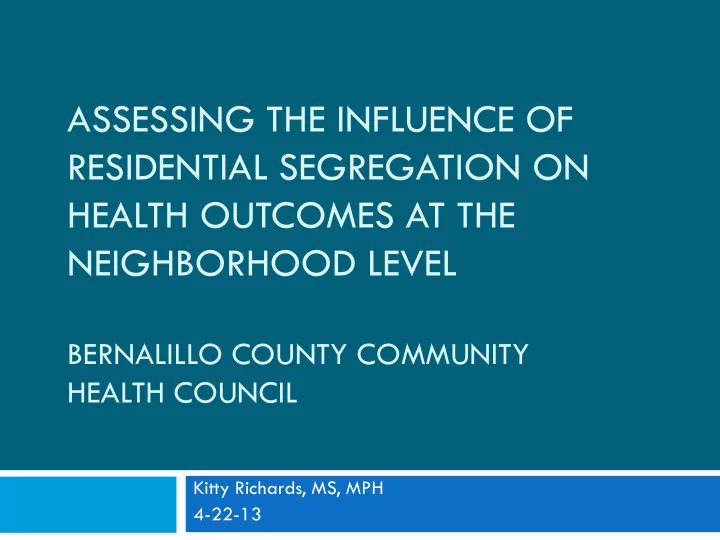

ASSESSING THE INFLUENCE OF RESIDENTIAL SEGREGATION ON HEALTH OUTCOMES AT THE NEIGHBORHOOD LEVEL BERNALILLO COUNTY COMMUNITY HEALTH COUNCIL Kitty Richards, MS, MPH 4-22-13
Problem - Background Neighborhoods characterized by racial and economic segregation are not only exposed to more environmental hazards, but also have access to fewer opportunities such as quality schools, well- paying jobs, and green spaces. Residents living in highly segregated and “opportunity poor” neighborhoods experience greater stress levels which contribute to physiological vulnerability and adverse health outcomes.
3
Community Health Equity Report Purpose To assess the associations between residential segregation by income and race/ethnicity, stress and health outcomes at the neighborhood level for Bernalillo County. To provide evidence to various County boards that disparities exist at the sub-count level.
CHER – Risk Factors and Health Outcomes Risk Factors Race/Ethnicity and Foreign Born Persistent Poverty Community Risk Index (standardized test scores, violent crime rate, foreclosure rate, unemployment rate, vacant homes, homes with no auto, and overcrowded households) Environmental Risk Index (landfills, RCRA sites, Superfund sites, toxic release inventory sites) Health Outcomes Life Expectancy All Cause Death Rate Low Birth Rate Infant Mortality Rate
Highlights 22-year difference in life expectancy across census tracts. Higher concentrations of environmental health hazards in non-white and low-income census tracts. A life expectancy that is an average of 5.2 years shorter in census tracts with the greatest concentration of environmental hazards.
History of San Jose 11 South Valley Superfund Site Responsible parties: GE, Chevron, among others Contamination of acequia and ground water by benzene and other contaminants Private and public wells closed down Acequia closed down – because produce was irrigated by the acequia San Jose Church and priest very involved in bringing corporations to justice and for paying damages
Impacted Communities and Bernalillo County Demographics & Socio-Economic Status 100% 90% 80% 70% 60% 50% 40% 30% 20% 10% 0% Hispanic Non-Hispanic Under 18 Years of Unemployment Spanish Spoken at Population under White Age Rate Home (> age 5) 150% Poverty Level San Jose Mountain View Bernalillo County
13
14
87114 87114 87122 87122 87122 87122 87113 87113 87109 87109 87109 87109 87111 87111 87107 87107 87120 87120 87110 87110 87104 87104 87112 87112 87102 87102 87106 87106 87108 87108 87123 87123 87116 87116 87118 87118 Hospitalizations for Asthma Hospitalizations for Asthma 87121 87121 87105 87105 Children 5 to 14 Children 5 to 14 Mean Annual Rates, 1996-2000 Mean Annual Rates, 1996-2000 Source: NM Health Policy Commission Source: NM Health Policy Commission 2 to 7 per 10,000 2 to 7 per 10,000 7 to 9 7 to 9 9 to 10 9 to 10 10 to 14 10 to 14 14 to 24 per 10,000 14 to 24 per 10,000 From Tom Scharmen NMDOH
AT&SF Rail 18
Distribution of Estimated Cancer Risks in US Metropolitan Areas, per Million Including Diesel Excluding Diesel 632 558 379 179 116 43 43 41 25 23 23 16 8 8 All Sources Background Major Sources Area Sources Mobile Sources On-road Mobile Nonroad Mobile Sources Sources
Rate of Death from All Causes in Hispanics Bernalillo County, 1990-2005 10,000 5333.8 Age-adjusted death rate per 100,000 4598.6 Mountainview-San Jose Area Rest of County 1024.9 1,000 828.7 401.6 283.3 100 All Ages <65 Years 65+ Years
The Sleeping Giant Wakes Up!! 22 Historically, Minorities had little voice in decisions that impacted them because of the times Today, Minorities are no longer afraid to speak out because they have become more aware of protective policies gained through things like the Civil Rights movement
Next Steps Legislation that considers the cumulative impacts of environmental exposures on a community’s health (CERA) Requirement to consider the health impacts of policies, plans or projects early on in the decision- making process (HIAP) Development of an evidence base through environmental monitoring and health assessment
Contact Kitty Richards, Bernalillo County Office of Health and Social Services 314-0338 Esther Abeyta Juan Reynosa, Southwest Organizing Project 247-8832, ext. 115
Recommend
More recommend